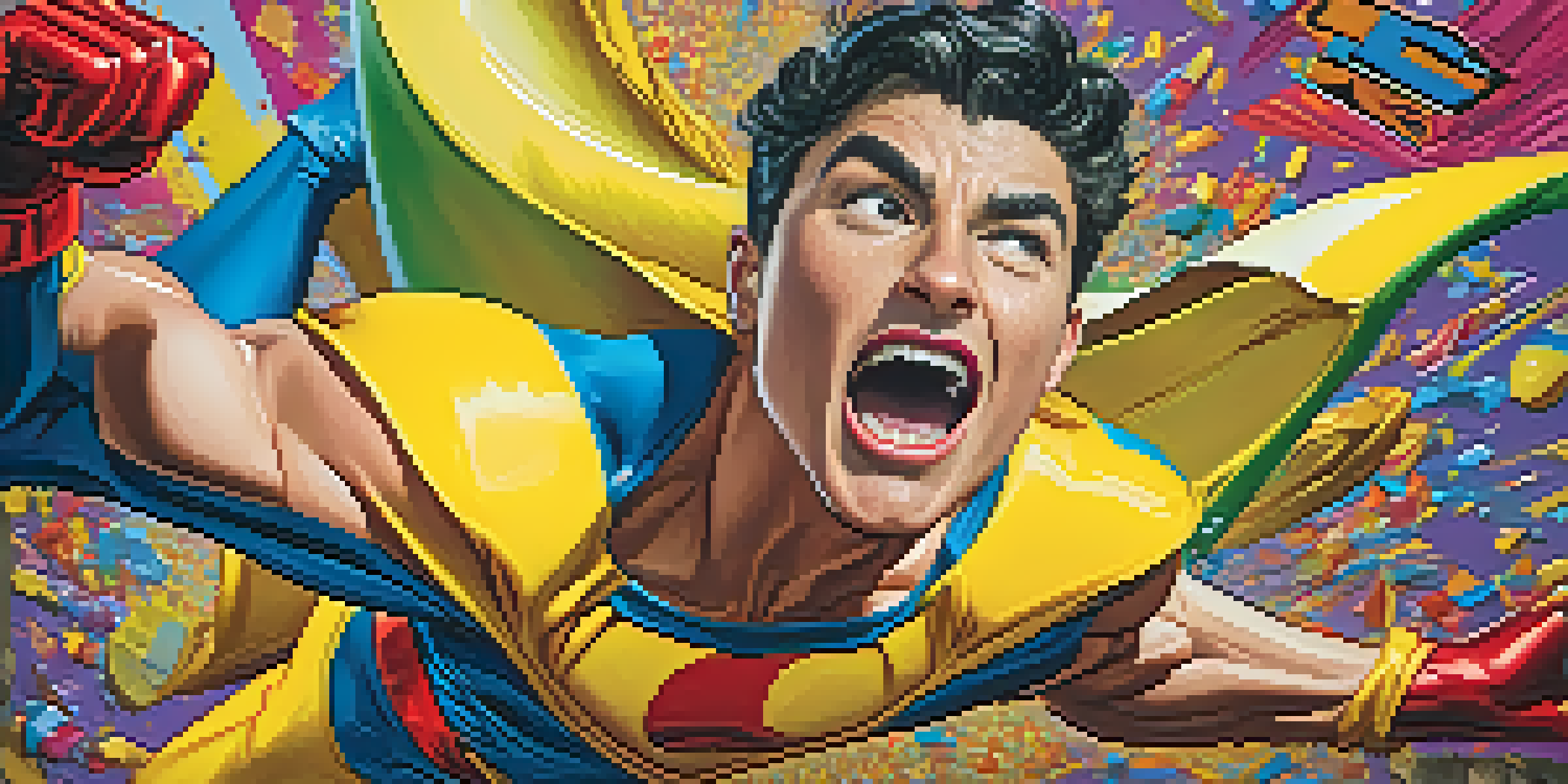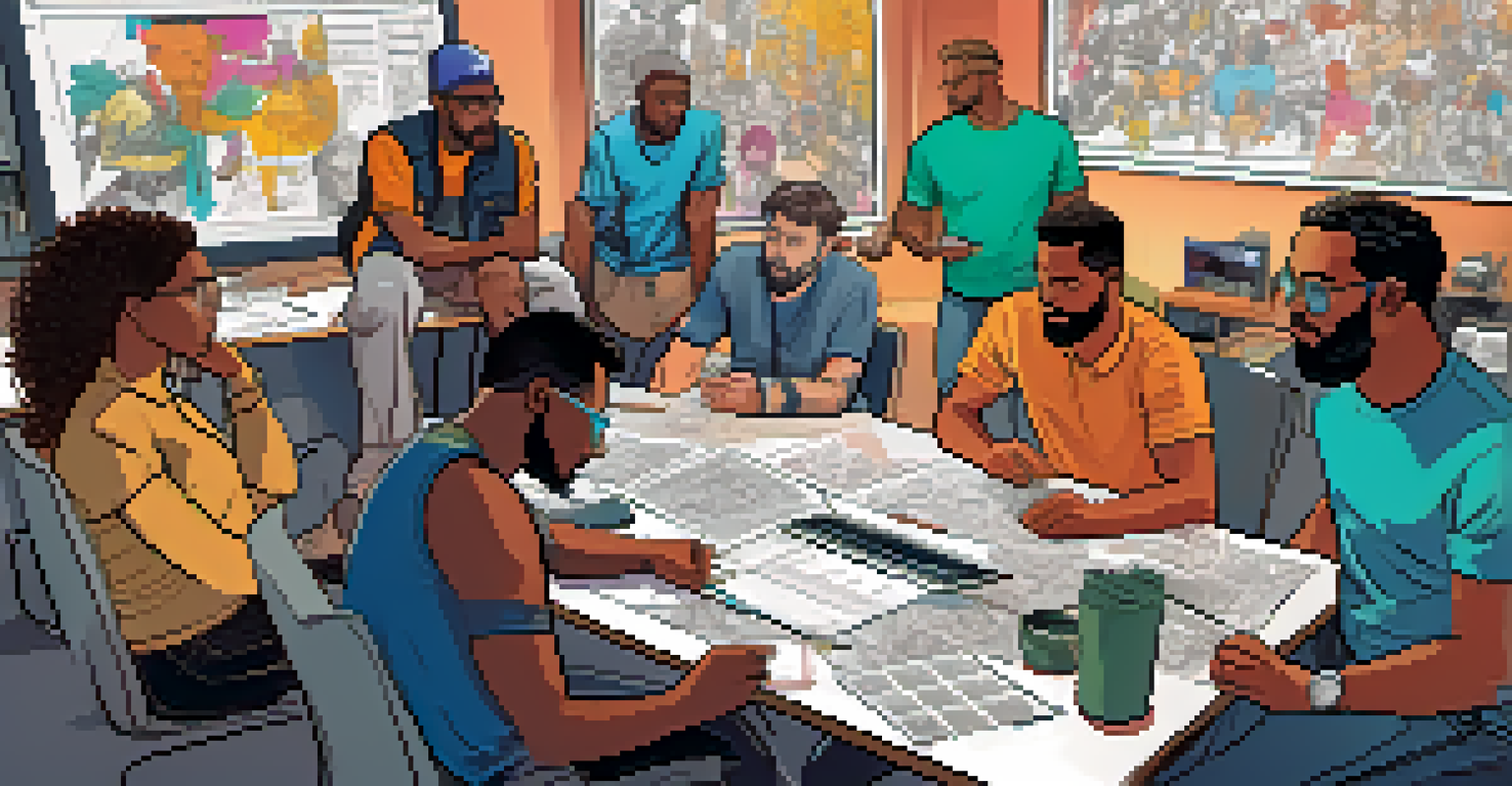Visual Storytelling: Humor in Comics and Graphic Novels

Understanding Visual Storytelling in Comics
Visual storytelling merges images and text to convey narratives effectively. Comics and graphic novels harness this power uniquely, allowing readers to experience stories through both visuals and words. This combination creates a dynamic medium where humor can thrive, engaging audiences on multiple levels.
Comics are a gateway for readers of all ages to experience humor and storytelling in a unique way.
In comics, the interplay between illustrations and dialogue can amplify comedic effects. For instance, a character's facial expression can add layers of meaning to a witty line, making the punchline even more impactful. This synergy is key to maintaining reader interest and enhancing the overall experience.
Moreover, visual storytelling allows for creative freedom in how humor is presented. Artists can use exaggerated expressions, visual gags, and clever layouts to deliver laughs, making the medium versatile and rich in comedic potential.
The Evolution of Humor in Comics
Humor in comics has evolved significantly since its inception. Early comic strips often relied on slapstick and simple jokes, catering to a more general audience. As the medium matured, humor became more nuanced, with deeper themes and character-driven stories emerging alongside traditional comedic elements.

This evolution reflects broader cultural shifts, where societal norms and expectations influence humor. For example, the rise of independent comics has allowed for diverse comedic voices, tackling topics that challenge the status quo while still making readers laugh. This variety showcases the adaptability of humor in the comic format.
Visual Humor Enhances Storytelling
The combination of visuals and text in comics amplifies comedic effects, creating a richer narrative experience.
Today, comics and graphic novels often blend humor with poignant storytelling, creating a balance that resonates with readers. They can address serious issues while providing levity, demonstrating that humor is not just about laughs but can also serve as a tool for connection and understanding.
The Anatomy of Humor in Graphic Novels
Understanding the elements of humor in graphic novels can enhance both creation and appreciation. Comedic timing, pacing, and visual cues play critical roles in delivering jokes effectively. For instance, a well-timed pause in a panel can build anticipation, making the punchline all the more satisfying.
The best comic strips and graphic novels use humor not just for laughs, but to illuminate the deeper truths of life.
Additionally, character development is vital for humor to resonate. Readers often find humor more relatable when it stems from well-crafted characters with distinct personalities. A character’s quirks or flaws can lead to hilarious situations, drawing readers into their world.
Lastly, the balance between humor and storyline is essential. While humor can provide levity, it should complement the narrative rather than overshadow it. This balance is key to maintaining engagement and ensuring that the humor serves the overall story.
Cultural Influences on Comic Humor
Cultural context heavily influences the humor found in comics and graphic novels. Different cultures have unique comedic styles, which often reflect societal norms, values, and experiences. Understanding these cultural nuances can deepen the appreciation of a comic's humor and its impact on readers.
For instance, Japanese manga often employs a distinct type of humor, characterized by exaggerated expressions and situational comedy. On the other hand, Western comics may lean toward sarcasm and satire, showcasing the diversity of humor across different cultures. This variety enriches the global comic landscape.
Cultural Context Shapes Comic Humor
Different cultures influence comedic styles in comics, showcasing a diverse array of humor that resonates with various audiences.
As comics spread across borders, they adapt and evolve, incorporating elements from various cultures. This cross-pollination can lead to innovative humor that appeals to a broader audience, demonstrating the universal nature of laughter.
The Role of Visual Gags in Humor
Visual gags are a cornerstone of humor in comics, providing an immediate and often hilarious punch. These gags rely on imagery rather than words, allowing for quick and impactful jokes that can resonate with readers of all ages. For example, a character slipping on a banana peel is a classic visual gag that transcends language barriers.
The effectiveness of visual gags often lies in their unexpectedness. A surprising twist in a panel can evoke laughter, making readers appreciate the cleverness behind the joke. This element of surprise can also enhance the overall reading experience, keeping audiences engaged.
Moreover, visual gags can serve to reinforce character traits or themes within a story. When a character consistently finds themselves in humorous situations, it can highlight their personality, making them more relatable and memorable to readers.
Balancing Humor with Serious Themes
One of the remarkable aspects of comics and graphic novels is their ability to tackle serious themes while incorporating humor. This balance allows for deeper storytelling, where humor can provide relief or offer new perspectives on difficult topics. For instance, exploring themes of loss or identity through humor can make these subjects more approachable.
Using humor in serious narratives can also create a more profound emotional impact. When readers can laugh, they may feel more open to reflecting on the serious themes at play. This connection fosters a sense of empathy, allowing readers to engage with the story on multiple levels.
Balancing Humor with Serious Themes
Comics effectively blend humor with serious topics, allowing for deeper emotional connections and more engaging storytelling.
Ultimately, the juxtaposition of humor and serious themes can create a richer reading experience. It encourages readers to think critically while still enjoying the lighter moments, showcasing the versatility of comics and graphic novels as a storytelling medium.
The Future of Humor in Comics and Graphic Novels
As the comic and graphic novel industry continues to evolve, so does the use of humor within it. Emerging technologies and platforms are reshaping how comics are created and consumed, opening new avenues for comedic expression. Webcomics and digital formats, for example, allow for rapid experimentation with humor, catering to diverse audiences.
Additionally, the rise of diverse voices in the industry is bringing fresh perspectives on humor. New creators are exploring unconventional themes and styles, pushing the boundaries of what humor can be in comics. This inclusivity promises to enrich the medium and offer readers a broader spectrum of comedic experiences.

Looking ahead, it's clear that humor will remain a vital component of comics and graphic novels. As creators continue to innovate and connect with audiences, we can expect to see humor evolve in exciting and unexpected ways, ensuring that laughter remains an integral part of visual storytelling.